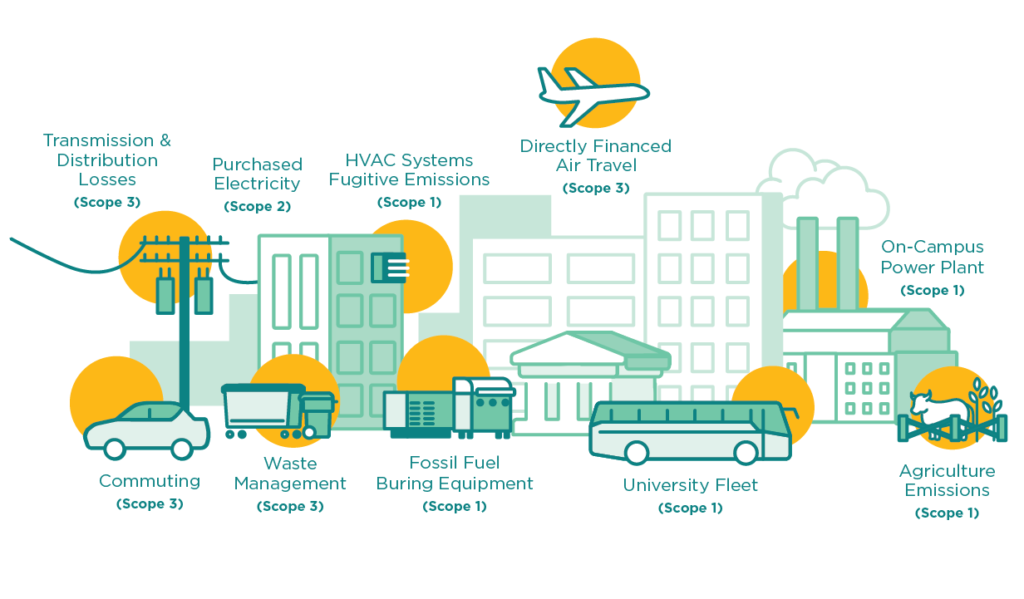
This blog post is a snippet of Nelnet’s new white paper with the same title.
Climate change: It’s real, and it’s happening. Between 1880 and 2022, the global temperature rose 1.01
degrees Celsius. Sea level has risen nearly 7 inches over the past 100 years. And eighteen of the hottest
years on record have occurred since 2000.1
With these hard truths, it’s no wonder 72% of Americans now believe that global warming is happening.2
(Since you’re reading this piece, we assume you’re in that group.) A University of Bath survey of 10,000
young people (aged 16-25 years) in 10 countries revealed that 59% of them were very or extremely
worried about climate change, and 84% at least moderately worried.3 Further, and perhaps more
importantly, 74% of college applicants say a college’s environmental commitment would affect their
decision of where to attend.4
Despite overwhelming scientific evidence that indicates a need for rapid decarbonization, at the writing
of this paper, there are only 15 higher education institutions in the U.S. that have achieved carbon
neutrality;5 these institutions represent about 0.25% of all colleges and universities in the U.S. While
only these precious few institutions have achieved carbon neutrality, hundreds more are working to
reach that goal by 2050.6
What you want to know is why we – and, more specifically your (current or former) institution – aren’t
doing more to mitigate and adapt to the effects of climate change. For most institutions, the failure to
achieve results is not for lack of trying. Legitimate hurdles stand in the way of rapid decarbonization, and
great intentions can only take you so far while managing limited resources and external roadblocks. The
goal of this piece is to explore what it takes for a higher education institution (HEI) in the U.S. to achieve
carbon neutrality; review key barriers to implementation; and provide strategies for how those barriers
can be overcome.
Let’s establish the basics. What is carbon neutrality?
Carbon neutrality is not equivalent to zero carbon emissions. Carbon neutrality requires that “any
actions that lead to emissions would be accompanied by other actions that confidently reduce – or
offset – emissions.”7 Carbon neutrality is often a catch-all term for achieving net zero greenhouse gas
(GHG) emissions, expanding beyond carbon to include methane, nitrous oxide, and sulfur hexafluoride.
For the purposes of this piece, carbon neutrality encompasses all GHG emissions.
GHG emissions traditionally have been broken into three categories or “scopes”8:
- Scope 1 Emissions: Direct GHG emissions that occur from sources that are controlled or owned
by your institution (i.e. the heating and cooling systems on your campus). - Scope 2 Emissions: Indirect GHG emissions associated with the generation of purchased power
(i.e. the energy your campus consumes via the electrical grid). - Scope 3 Emissions: All other indirect GHG emissions that occur in your institution’s value supply
chain (i.e. study abroad travel and commuting patterns).
HEIs looking to achieve carbon neutrality must reduce their GHG emissions to the greatest extent
possible and then offset any remaining emissions by preventing or removing an equivalent amount from
the atmosphere through the purchase or generation of offsets or credits.
Research led by Alexander R. Baron at Smith College and published in September 2021 found that
purchased offsets “are the single largest source of reductions for nine of the 11 schools that have
announced carbon neutrality” with one institution achieving carbon neutrality with essentially no net
on-site reductions, accomplished entirely through the purchase of offsets.9
For institutions truly looking to have a positive impact on the local and global environment, carbon
neutrality itself should not be the end goal. Colleges and universities that integrate sustainability on
campus find a host of co-benefits – starting with increased energy resiliency for their campus and the
larger community. In addition, they significantly reduce operational costs, provide valuable educational
and research opportunities for students and faculty, and inspire students to integrate sustainability into
their lives as they move throughout the world. Technically, a school can reach carbon neutrality by
purchasing carbon offsets equivalent to the amount of their GHG emissions – but this provides none of
the additional co-benefits of a secure, resilient, sustainable institution.
So, the real goal: reduce all emissions to the greatest extent possible and invest in carbon removal
projects to offset the remaining emissions.
The remainder of the content can be found in our white paper “Why Your College Hasn’t Achieved Carbon Neutrality (Yet)”. Additional sections include:
- A typical campus’s emissions structure
- What projects do institutions need to undertake to achieve carbon neutrality?
- General Measures
- Scope 1
- Scope 2
- Scope 3
- What’s preventing your institution from achieving carbon neutrality as soon as possible?
- How to overcome those barriers
- Where do I get started?
About the Author
Scot Bearss, PMP
Project Leader, Net Zero
Nelnet Renewable Energy
scot.bearss@nelnet.net | 714.421.1287
Scot Bearss is the Project Leader for Net Zero. Prior to coming to Nelnet, he worked at Yale University for four years, the majority of which was in the sustainability office leading communications and outreach, as well as developing department-specific sustainability action plans. He earned his Project Management Professional (PMP) certification in May of 2022, with over 7,500 hours of project management experience.
References
1 https://climate.nasa.gov/
2 https://climatecommunication.yale.edu/visualizations-data/ycom-us/
3 https://www.npr.org/2021/09/14/1037023551/climate-change-children-young-adults-anxious-worried-study
4 https://www.princetonreview.com/college-rankings/college-hopes-worries
5 https://secondnature.org/climate-action-guidance/carbon-neutral-colleges-and-universities/
6 Race to Zero, https://www.educationracetozero.org/current-signatories
7 Ken Gillingham, https://sustainability.yale.edu/explainers/yale-experts-explain-carbon-neutrality
8 US EPA, https://www.epa.gov/climateleadership/scope-1-and-scope-2-inventory-guidance
9 https://www.sciencedirect.com/science/article/pii/S2590332221004723